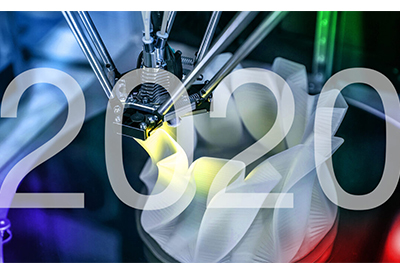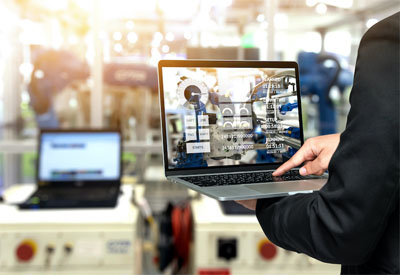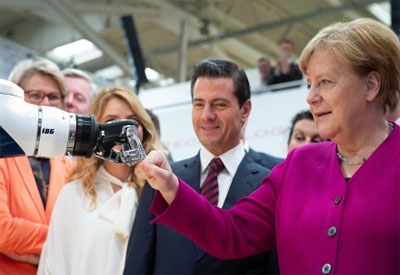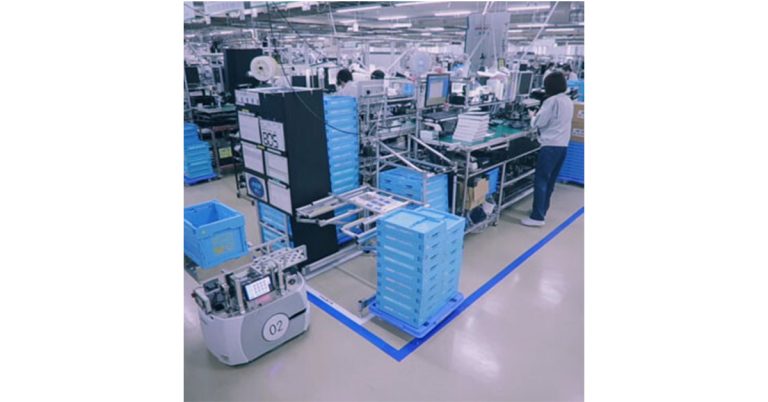Getting ready for 2020 – The 5 trends driving innovation in manufacturing

February 6, 2020
As the 2010’s come to an end, the beginning of a new decade represents a symbolic moment for manufacturers of all sizes to step back and reflect on the trends, technologies, and approaches driving the industry forward. With the accelerated adoption of new capabilities and technologies such as additive manufacturing, data and analytics, and digital twin technology, combined with a shift toward a more purpose-driven approach and an increased emphasis on design and strategy, manufacturers will be tasked with creating a plan that positions their organization for long-term success and growth.
Here are 5 of the trends we see driving manufacturing innovation in 2020.
1) Additive manufacturing
It’s estimated that the global additive manufacturing market is expected to reach $23.33 billion by 2026, up significantly from around $9 billion in 2018. Additive manufacturing, commonly known as 3D printing, has long been viewed as the future of small batch manufacturing and customized products, but advancements that have made it more flexible, versatile, and cost-effective mean it is now finally delivering on its potential.
Deloitte suggests that additive manufacturing can significantly reduce time to market for new products or product modifications by making it easy for companies to build prototypes and test new designs without acquiring new tools or incurring additional development costs. The layer-by-layer approach makes it possible to build complex, composite, and hybrid structures that traditional production techniques struggle with, opening up new possibilities for product design and functionality. It also enables companies to shift away from mass production toward a model of mass customization, since product changes do not require changeovers or the retooling of machines. Finally, replacement parts or components can be built with a just-in-time approach, reducing equipment downtime, minimizing inventory costs, and simplifying supply chains.
2) Data, analytics, artificial intelligence, and machine learning
The manufacturing environment is a goldmine of potential data. Unfortunately, Forrester reports that between 60 and 73 percent of enterprise data goes unused. Companies who successfully capture, analyze, and use this data gain a better understanding of their factory environment and can make meaningful changes that directly impact business results. From tracking equipment performance and increasing overall equipment effectiveness (OEE) to managing product quality and reducing defect rates, the data that’s most relevant to you will depend on the outcome you want to achieve.
To help make sense of all of this data, manufacturers will need to invest in analytics software, artificial intelligence (AI), and machine learning (ML) capabilities. Powerful analytics software allows decision makers to spot trends and gain insights in real-time to make improvements to equipment, workflows, processes, or the deployment of workers. AI and ML can process large amounts of data to make predictions about future trends, enable pre-emptive maintenance, or automate logistics and supply chain operations.
3) Digital twin technology
Digital twin technology has the potential to redefine how companies visualize their factory environments. Though Gartner says that only 13 percent of organizations are currently using digital twins, 62 percent are in the process of establishing the technology or plan to do so in the next year. A digital twin goes beyond a traditional model to create a virtual, 3-dimensional, and interactive digital replica of a piece of equipment, a production facility, or a product itself. By leveraging real-time data, advanced physics engines, and powerful predictive analytics, a digital twin makes it possible to see not only how a facility currently operates, but how it would operate if changes were made to equipment, machinery, processes, or workflows.
For example, manufacturers can investigate how adding a new, high speed piece of equipment would impact employees and machines down the line. They can reorganize the production line and workflows to understand how products move through their facility. Or they can see how a product responds to a variety of real-world conditions, identifying faults or issues before it is delivered to the customer. Most importantly, manufacturers can do all of this without going through the costly and disruptive exercise of testing in real life.
4) Purpose-driven investments
Stepping away from technology, one of the biggest shifts over the past decade has been the move toward purpose-driven investing and the emphasis on environmental, social, and governance (ESG) issues. Today’s manufacturers need to go beyond the bottom line and focus on the larger purpose of their organization, understanding how their decisions impact employees, customers, the environment, and the communities they operate in.
Harvard Business Review found that employees who derive meaning and purpose from their work are nearly twice as satisfied and three times more likely to stay with their current organization. Forbes has also shown that 91 percent of customers would switch brands to one that was purpose-driven if they offered a similar price and quality. Finally, DDI found that companies who both articulated and acted on their purpose outperformed the market by 42 percent.
5) A focus on design and planning
Historically, manufacturers have fallen into the trap of taking a shotgun approach to implementing new technology and equipment. As a result, they have often been stuck dealing with legacy equipment that is unable to integrate into other systems, complex production processes, and unanticipated bottlenecks or other throughput issues. All of this leads to lower productivity and efficiency, higher costs, and reduced profits.
In response, companies are renewing their focus on design and strategic planning before implementing new equipment. Companies that are successful in their technology deployments are taking a big picture view of their facility to understand how changes in one area affect other parts of their facilities. This allows them to identify where changes can have the biggest impact on their results and ensure machines, workflows, and processes can be expanded and built upon as their needs evolve and grow.
2020 – The beginning of a new era in manufacturing
As we look ahead to the coming years, the impact of technology and innovation will continue to drive manufacturers of all sizes to make improvements to their facilities. Understanding what’s coming will allow you to evaluate how technology fits into your production environment and identify how you can make the most from your investments. With a strategic approach and an ability to take a big picture view of your facility, you’ll be able to choose the right technologies for your business and build a sustainable and competitive business ready for the future.
















